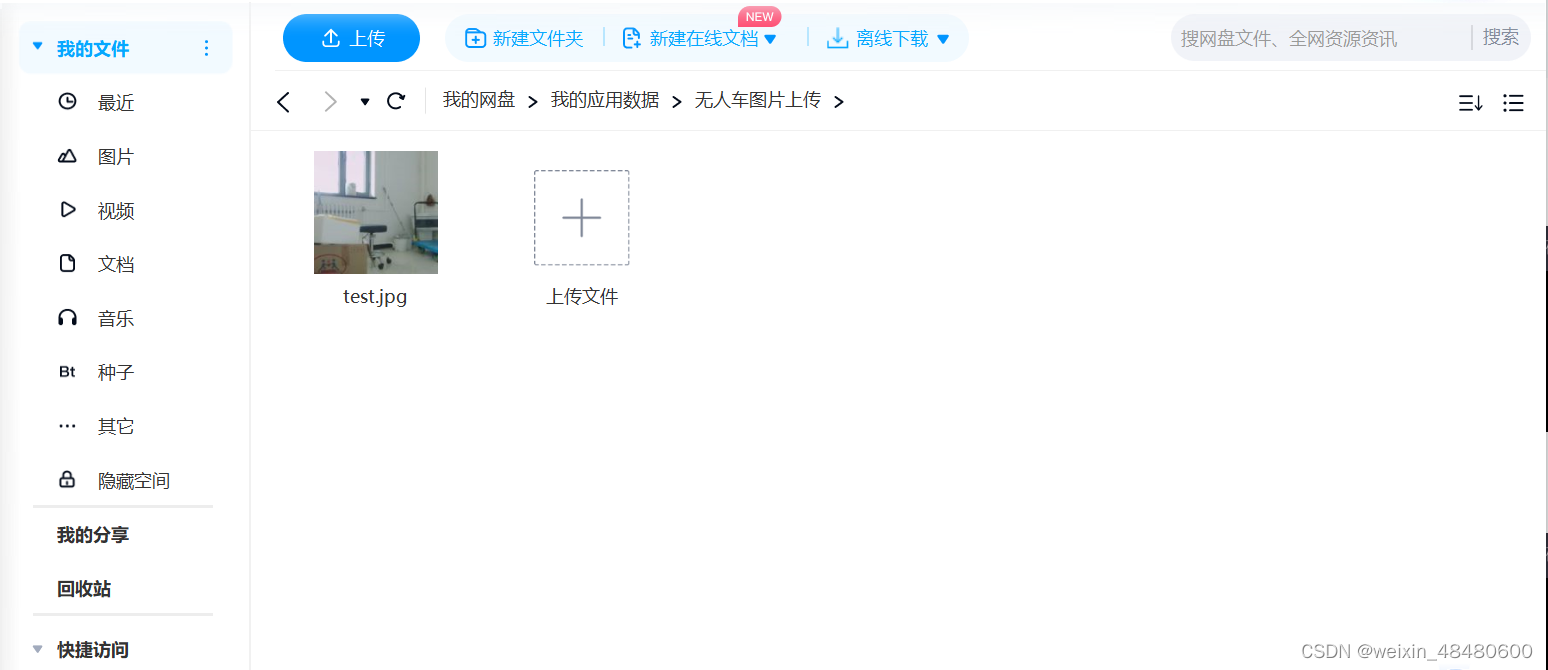先上一张上传成功截图

运行代码如下
# !/home/***/anaconda3/bin/python #选择合适的python版本
"""
xpan upload
include:
precreate
upload
create
"""
import os
import sys
BASE_DIR = os.path.dirname(os.path.dirname(os.path.abspath(__file__)))
sys.path.append(BASE_DIR)
from pprint import pprint
from openapi_client.api import fileupload_api
import openapi_client
import hashlib
def precreate():
"""
precreate
"""
# Enter a context with an instance of the API client
with openapi_client.ApiClient() as api_client:
# Create an instance of the API class
api_instance = fileupload_api.FileuploadApi(api_client)
access_token = "***" #填入自己的access_token
path = "/apps/***/test.jpg" # str | 对于一般的第三方软件应用,路径以 "/apps/your-app-name/" 开头。对于小度等硬件应用,路径一般 "/来自:小度设备/" 开头。对于定制化配置的硬件应用,根据配置情况进行填写。
block_list = ''
file_path = "/***/test.jpg" #要上传的文件的真实路径
with open(file_path, 'rb') as f:
data = f.read()
file_md5 = hashlib.md5(data).hexdigest() #获取上传文件md5
block_list = block_list+'["{}"]'.format(file_md5) #放入block_list
print(block_list)
size = os.path.getsize(file_path) #获取上传文件大小
print(size)
isdir = 0 # int | isdir
autoinit = 1 # int | autoinit
rtype = 3 # int | rtype (optional)
try:
api_response = api_instance.xpanfileprecreate(
access_token, path, isdir, size, autoinit, block_list, rtype=rtype)
pprint(api_response)
uploadid = api_response['uploadid'] #获取预上传返回的uploadid,传给upload和create函数
except openapi_client.ApiException as e:
print("Exception when calling FileuploadApi->xpanfileprecreate: %s\n" % e)
return access_token, path, isdir, size, uploadid, block_list, rtype, file_path
def upload(uploadid,path,file_path, access_token):
"""
upload
"""
# Enter a context with an instance of the API client
with openapi_client.ApiClient() as api_client:
# Create an instance of the API class
api_instance = fileupload_api.FileuploadApi(api_client)
partseq = "0" # str |
type = "tmpfile" # str |
try:
file = open(file_path, 'rb')
except Exception as e:
print("Exception when open file: %s\n" % e)
exit(-1)
# example passing only required values which don't have defaults set
# and optional values
try:
api_response = api_instance.pcssuperfile2(
access_token, partseq, path, uploadid, type, file=file)
pprint(api_response)
except openapi_client.ApiException as e:
print("Exception when calling FileuploadApi->pcssuperfile2: %s\n" % e)
def create(access_token, path, isdir, size, uploadid, block_list,rtype):
"""
create
"""
# Enter a context with an instance of the API client
with openapi_client.ApiClient() as api_client:
# Create an instance of the API class
api_instance = fileupload_api.FileuploadApi(api_client)
# example passing only required values which don't have defaults set
# and optional values
try:
api_response = api_instance.xpanfilecreate(
access_token, path, isdir, size, uploadid, block_list, rtype=rtype)
pprint(api_response)
except openapi_client.ApiException as e:
print("Exception when calling FileuploadApi->xpanfilecreate: %s\n" % e)
if __name__ == '__main__':
access_token, path, isdir, size, uploadid, block_list, rtype, file_path = precreate()
upload(uploadid,path,file_path, access_token)
create(access_token, path, isdir, size, uploadid, block_list,rtype)把access_token,文件路径,上传路径修改为自己的,运行即可





















 7528
7528











 被折叠的 条评论
为什么被折叠?
被折叠的 条评论
为什么被折叠?








